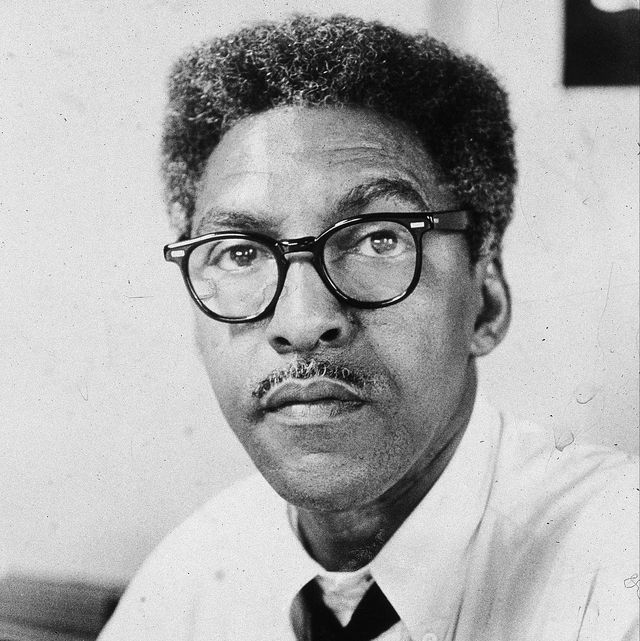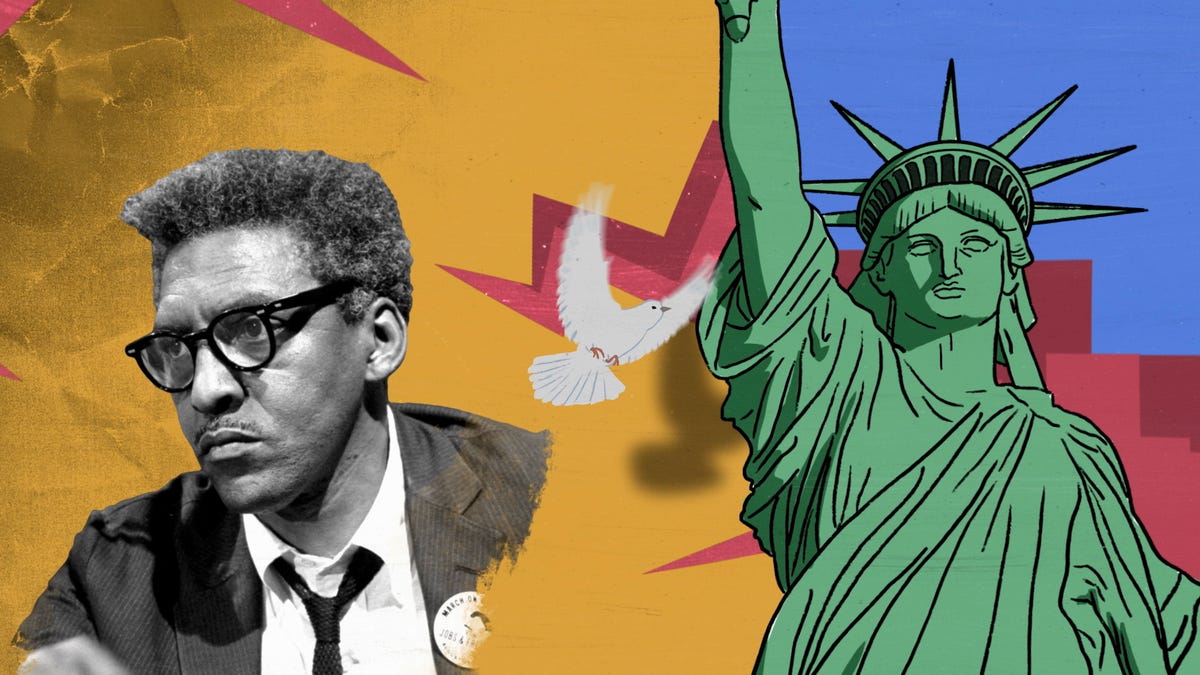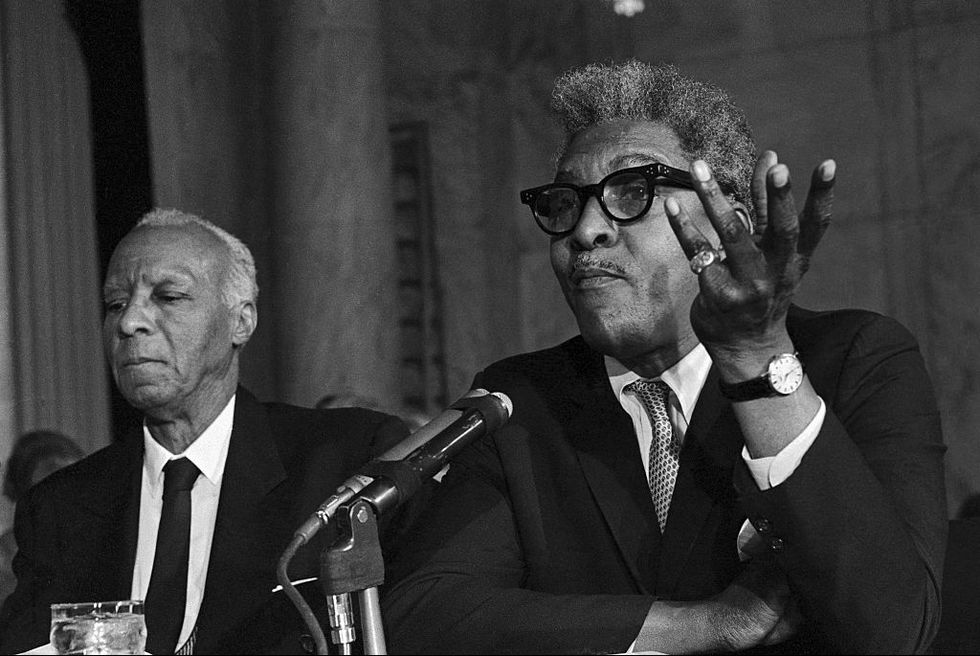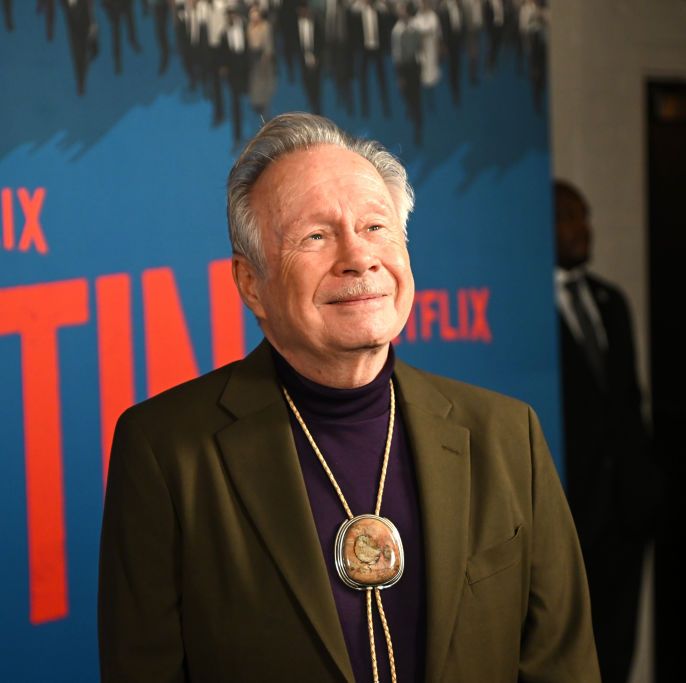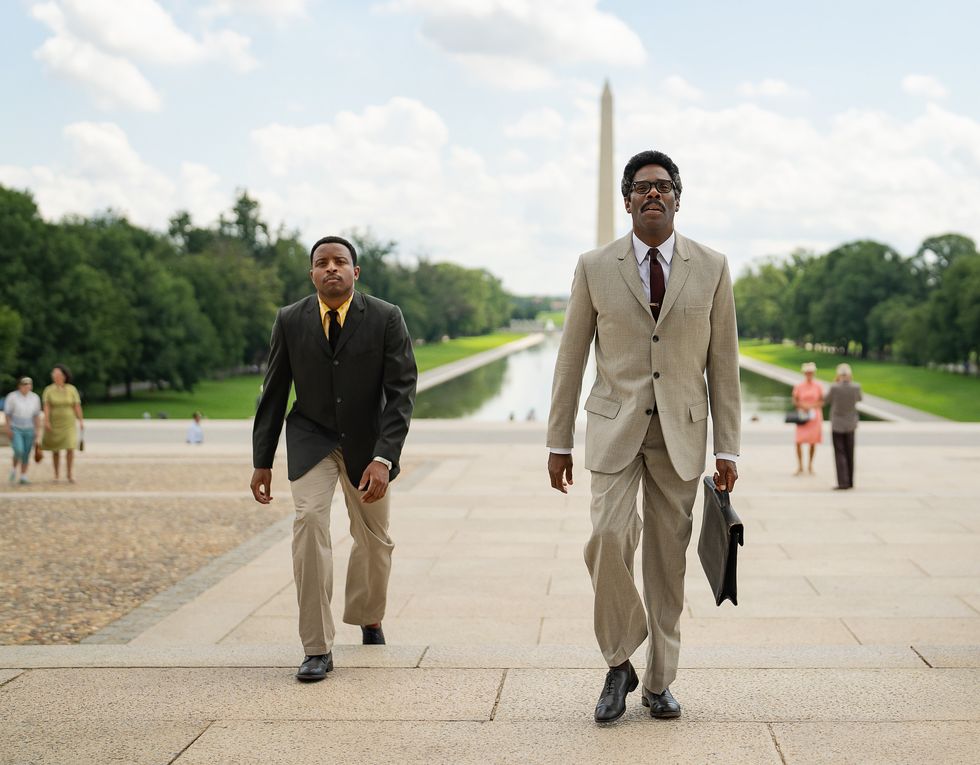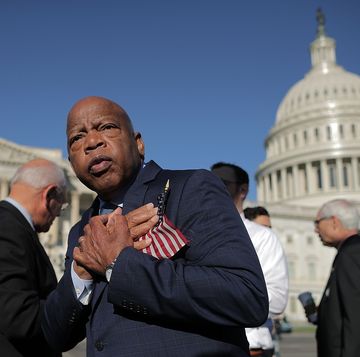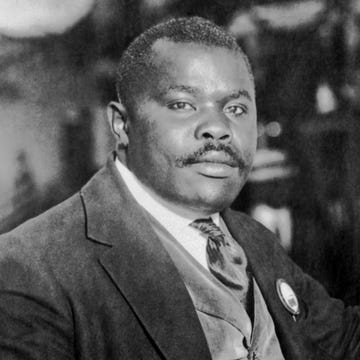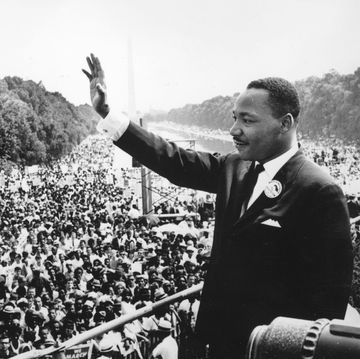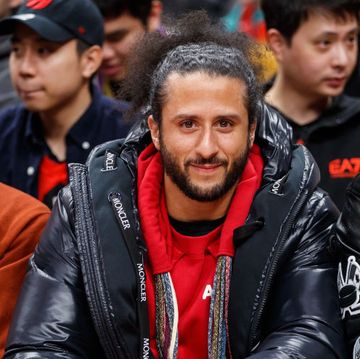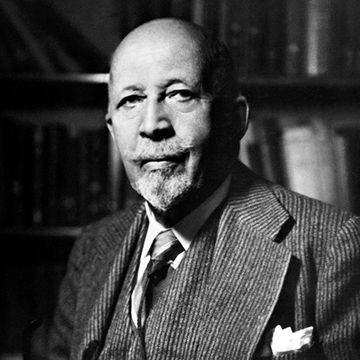1912-1987
Bayard Rustin Today: Activist’s Story Told in Netflix Movie Rustin
Civil rights activist Bayard Rustin and his efforts in organizing the famous March on Washington in 1963—where Martin Luther King Jr. gave his iconic “I Have a Dream” speech—are the subject of the new biopic Rustin, which is now streaming on Netflix starting November 17. The movie is produced by former President Barack Obama and Michelle Obama’s company Higher Ground and stars Colman Domingo as Rustin. The Associated Press praises Domingo’s “layered, astute performance” and calls the film “as vibrant as the movement it covers.”
Who Was Bayard Rustin?
Bayard Rustin began his lifelong activism work after moving to New York in the 1930s, where he was involved in pacifist groups and early civil rights protests. Combining nonviolent resistance with organizational skills, he was a key adviser to Martin Luther King Jr. in the mid-1950s. With labor leader A. Philip Randolph, he originated the idea and led the organizing effort for the 1963 March on Washington. It remains one of the largest peaceful demonstrations in American history and paved the way for the passage of key civil rights legislation. Although Rustin was arrested several times for his civil disobedience and open homosexuality, he continued to fight for equality until his death in 1987 at age 75.
Quick Facts
FULL NAME: Bayard Taylor Rustin
BORN: March 17, 1912
DIED: August 24, 1987
BIRTHPLACE: West Chester, Pennsylvania
ASTROLOGICAL SIGN: Pisces
Early Life and Education
Bayard Taylor Rustin was born on March 17, 1912, in West Chester, Pennsylvania. He had been raised to believe that his parents were Julia and Janifer Rustin, when in fact they were his grandparents. He discovered the truth before adolescence, that the woman he thought was his sister, Florence, was in fact his mother. Young Florence had Rustin with West Indian immigrant Archie Hopkins.
Rustin attended Wilberforce University in Ohio and Cheyney State Teachers College (now Cheyney University) in Pennsylvania, both historically Black schools. In 1937, he moved to New York City and studied at City College of New York. He was briefly involved with the Young Communist League in 1930s before he became disillusioned with its activities and resigned.
Civil Rights Activism and Philosophy
In his personal philosophy, Rustin combined the pacifism of the Quaker religion, the nonviolent resistance taught by Mahatma Gandhi, and the socialism espoused by labor leader A. Philip Randolph. During the World War II, he worked for Randolph fighting against racial discrimination in war-related hiring. After meeting minister and labor organizer A. J. Muste, he also participated in several pacifist groups, including the Fellowship of Reconciliation.
Rustin was punished several times for his beliefs and his sexuality. During the war, he was jailed for two years when he refused to register for the draft. When he took part in protests against the segregated public transit system in 1947, he was arrested in North Carolina and sentenced to work on a chain gang for several weeks. In 1953, he was arrested on a morals charge for publicly engaging in homosexual activity and sent to jail for 60 days. However, he continued to live as an openly gay man.
By the 1950s, Rustin was an expert organizer of human rights protests. In 1958, he played an important role in coordinating a march in Aldermaston, England, in which 10,000 attendees demonstrated against nuclear weapons.
Martin Luther King Jr. and the March on Washington
Rustin met the young civil rights leader Martin Luther King Jr. in the 1950s and began working with King as an organizer and strategist in 1955. He taught King about Gandhi’s philosophy of nonviolent resistance and advised him on the tactics of civil disobedience. He assisted King with the boycott of segregated buses in Montgomery, Alabama, that began in late 1955. Other key leaders of the boycott—sparked by Rosa Parks’ refusal to give up her bus seat—included Jo Ann Robinson, Ralph Abernathy, and Ed Nixon.
King, Rustin, and other organizers created the Southern Christian Leadership Conference in 1957, not long after the Montgomery Bus Boycott successfully ended. But three years later, prejudice about Rustin’s homosexuality created distance between the famous reverend and the master organizer. King was advised to cut ties with Rustin because he was gay. “I told Dr. King that if advisors closest to him felt I was a burden, then rather than put him in a position that he had to say leave, I would go,” Rustin later recalled. “He was just so harassed that I felt it was my obligation to relive him of as much of that as I could.”
Rustin left the SCLC, but the pair continued collaborating. “Although Dr. King had been relieved by my officially leaving, he continued to call on me,” Rustin said. By 1963, they were back to working closely together in preparation for the March on Washington, at which King delivered his legendary “I Have a Dream” speech.
Arguably his most lasting contribution to the Civil Rights Movement, Rustin was an architect of the March on Washington for Jobs and Freedom, held on August 28, 1963. He and his mentor A. Philip Randolph originated the idea, convinced King to participate, and invited other prominent activists and groups to join them.
His radical views and homosexuality forced Rustin to take a less public role in the march’s execution, acting as deputy to Randolph as the director. Still, his impact was undeniable. “Bayard was the real general here, and he acted like a general, telling us all what to do and when to do it and how to do it,” Eleanor Holmes Norton, who contributed to the planning, told CBS News. “You needed an organizer, but you needed somebody with charisma to make you want to follow him. That was his gift.”
The organizers invited multiple celebrities to appear at the event, including actor Marlon Brando, actor and singer Lena Horne, musician Harry Belafonte, and performer Josephine Baker. They were among the estimated 250,000 people in attendance, far higher than the 100,000 people Rustin expected. It remains one of the largest peaceful demonstrations in American history.
In early September, Rustin and Randolph appeared on the cover of Life magazine. The March on Washington is credited with paving the way for the passage of the Civil Rights Act of 1964 and the Voting Rights Act of 1965.
Later Career
In 1965, Rustin and Randolph cofounded the A. Philip Randolph Institute, a labor organization for Black trade union members. He led the group until 1979. Rustin also continued his work within the civil rights and peace movements, and was much in demand as a public speaker.
Rustin received numerous awards and honorary degrees throughout his career. His writings about civil rights were published in the collection Down the Line in 1971 and in Strategies for Freedom in 1976. He continued to speak about the importance of economic equality within the Civil Rights Movement, as well as the need for social rights for people in the LGBTQ community.
Relationship with Walter Naegle
Because same-sex marriage wasn’t legal in any U.S. state until 2003, Rustin never married. However, he did have two notable long-term relationships, first with Davis Platt early in his career and later with activist Walter Naegle over the final ten years of his life.
Rustin and Naegle met in New York City in 1977. Rustin, 65 at the time, was 38 years older than Naegle. In order to acquire legal protection for their relationship, Rustin adopted Naegle in 1982. “We actually had to go through a process as if Bayard was adopting a small child,” Naegle told NPR in 2015. “My biological mother had to sign a legal paper, a paper disowning me... But, you know, we did what we did because we loved each other, and we were happy together.”
Rustin left Naegle as the executor of his estate following his death. Naegle established the Bayard Rustin Fund, a nonprofit that helps raise awareness of his contributions and preserves his legacy. He also assisted in the making of the 2003 documentary Brother Outsider: The Life of Bayard Rustin.
Death
Rustin died from cardiac arrest caused by a ruptured appendix in New York City on August 24, 1987, at the age of 75. President Ronald Reagan released a statement following his death calling Rustin “a great leader in the struggle for civil rights in the United States and for human rights throughout the world.”
New York City Mayor Ed Koch dedicated a plaque honoring Rustin in August 1989 that’s located in Ralph Bunche Park in Manhattan. In 2013, Barack Obama posthumously awarded Rustin the Presidential Medal of Freedom.
Rustin Movie
Rustin is the subject of a 2023 November biopic aptly titled Rustin. Colman Domingo plays Rustin in the Netflix movie. Chris Rock plays civil rights activist Roy Wilkins, and Aml Ameen portrays Martin Luther King Jr.
The movie focuses on Rustin’s efforts to plan the March on Washington across six weeks in 1963. Director George C. Wolfe said his own experiences during the Civil Rights Movement in the South—as a child, he and his grandmother attended a march with King in Kentucky—helped inform his casting decisions and creative choices for the film. He also jumped at the opportunity to tell the story of a crucial but often overlooked figure. “This was a man whose ferocity and sense of justice and correctness seemed to be embedded in every fiber of his being,” Wolfe said of Rustin. “History... it forgot him. It, in point of fact, erased him.”
Quotes
- I believe in social dislocation and creative trouble.
- People will never fight for your freedom if you have not given evidence that you are prepared to fight for it yourself.
- If we desire a society without discrimination, then we must not discriminate against anyone in the process of building this society.
- There are three ways to deal with injustice. One is to accept it slavishly. Or one can resist it with arms. Or one can use nonviolence. The man who believes in nonviolence is prepared to be harmed, to be crushed. But he will never crush others.
Fact Check: We strive for accuracy and fairness. If you see something that doesn't look right, contact us!
The Biography.com staff is a team of people-obsessed and news-hungry editors with decades of collective experience. We have worked as daily newspaper reporters, major national magazine editors, and as editors-in-chief of regional media publications. Among our ranks are book authors and award-winning journalists. Our staff also works with freelance writers, researchers, and other contributors to produce the smart, compelling profiles and articles you see on our site. To meet the team, visit our About Us page: https://www.biography.com/about/a43602329/about-us
Tyler Piccotti first joined the Biography.com staff as an Associate News Editor in February 2023, and before that worked almost eight years as a newspaper reporter and copy editor. He is a graduate of Syracuse University. When he's not writing and researching his next story, you can find him at the nearest amusement park, catching the latest movie, or cheering on his favorite sports teams.
